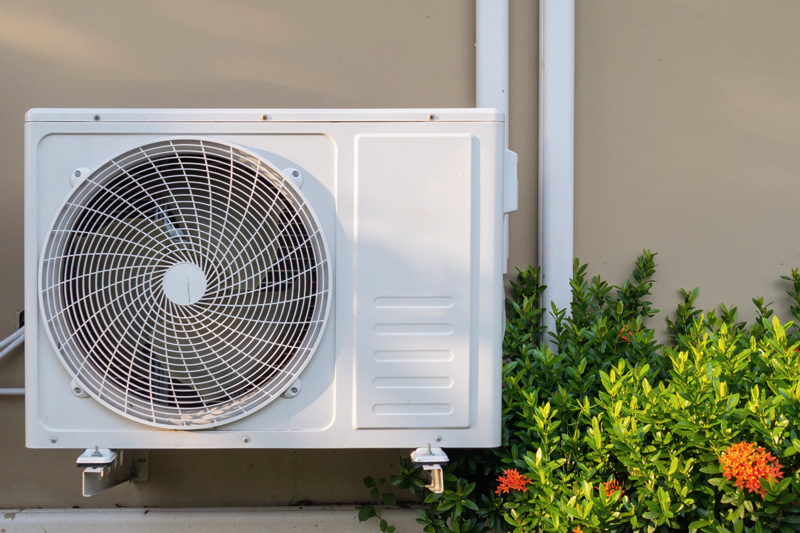Heating and cooling: Heat pumps
Use up to 70% less energy



The new era in home heating and cooling
A heat pump will both heat your home in the winter and cool it in the summer
Space heating accounts for 60% of the energy used in the average Canadian home. For electrically heated homes, you may be able to Use up to 70% less energy and substantially reduce your heating costs if you install an all-electric heat pump.
Three types of heat pumps:
Heat pumps – air-source
An air-source heat pump is an electrical device that uses the difference between outdoor air temperatures and indoor air temperatures to cool and heat your home.
Acting as a high-efficiency air conditioner in the summer, and a heater in the winter, an air-source heat pump uses a refrigerant that responds to temperature. In summer, a heat pump will move heat out of your home and release it outdoors. In fall, it brings heat into your home from outside, even when it's chilly (0°C). Many homes can rely on these products to heat or cool their homes year-round.
What to look for

- In Durham Region, a supplementary heating source is usually needed. Purchasing a
cold-climate
heat pump can help reduce reliance on this supplementary heating source. - For installation, hire a professional heating and cooling technician who can determine the proper size and right product for your home and climate.
- Service your heat pump at the end of summer before the start of the next heating season.
- Clean your filters and coils every month, as this will impact on the performance of your system and operating life.
Things to consider
- Pair with a smart thermostat, to better manage your home's energy use.
- When buying any heat pump, two ratings will help you determine the unit's efficiency:
- the Heating Seasonal Performance Factors (HSPF) that determines the efficiency during winter; and
- the Energy Efficiency Ratio (EER) is used for summer.
- In both cases the higher the number, the better the efficiency.
- An ENERGY STAR® certified air-source heat pump which use on average, 5% less energy than a standard model.
Average cost
$2,500 to more than $5,000 per unit, including installation.
Source: Natural Resources Canada
Heat pumps – ductless mini-split
A ductless mini-split system is an energy-efficient heating and cooling system that doesn't require ductwork, making them ideal for older electrically-heated homes and/or homes with no ductwork. Also known as ductless heat pumps, they take advantage of the difference in temperature between outdoor and indoor air to heat or cool a room. The temperature can be adjusted through a wall-mounted console, remote control or smartphone app. Ductless units require only a very small hole to be drilled into an exterior wall, making them less vulnerable to air leakage and security problems.
Mini-splits also avoid the energy losses associated with ductwork, which can account for more than 30% of the energy used to heat or cool indoor air.
What to look for

- Choose an ENERGY STAR® certified ductless heating and cooling system to cut your electrical heating bill by up to 60%, and your cooling bill by 30%, depending on your climate.
Things to consider
- Pair the system with a smart thermostat to better manage your home's energy use.
- For installation, hire a professional heating and cooling technician who can determine the right product and size for your home and climate.
Average cost
$2,500 to $5,000+ per unit, including installation.
Source: Natural Resources Canada
Heat pumps – ground-source
Ground-source heat pumps, also known as geothermal heat pumps, use the earth, groundwater or both to heat your home in the winter and cool it in the summer, and supply hot water. Ground-source heat pumps are more effective at heating homes during Canadian winters and provide greater energy savings than air-source heat pumps because in the winter underground temperatures are higher than air temperatures.
Ground source heating produce less CO2 than other forms of space heating systems.
What to look for
- Find a qualified, licensed contractor who can access your home and your needs.
- There are two important energy efficiency ratings: the Heating Seasonal Performance Factor (HSPF) indicates its efficiency in the winter, and the Energy Efficiency Ratio (EER) indicates efficiency in the summer. In both cases the higher the number, the higher the efficiency.
Things to consider
- Ground-source heat pumps are expensive and the installation process requires significant work and disruption to your garden, but they have a long life expectancy. The indoor components (the heat pump) typically last for 25 years, while the ground loops can last for more than 50 years.
- Ground source heat pumps will generally heat your unit at a slightly lower temperature than a traditional gas or electric unit
- Pair your heat pump with a smart thermostat, to better manage energy use.
- Service your pump at the end of the summer, before the next heating season.
Average cost
$20,000 – $40,000, including installation.
Source: Natural Resources Canada
Learn all about heat pumps:
Watch the Heat Pump Benefits webinar
You may also be interested in a heat pump water heater
Four rebate programs available for heat pumps:
Financial help available for heat pumps
All incentive programs available
Learn what heat pump type is best for your home and how to maximize your rebate savings:
Talk to a Home Energy Coach
by phone or virtual meeting
Durham Region residents can get free expert and personalized advice from a trained Home Energy Coach
